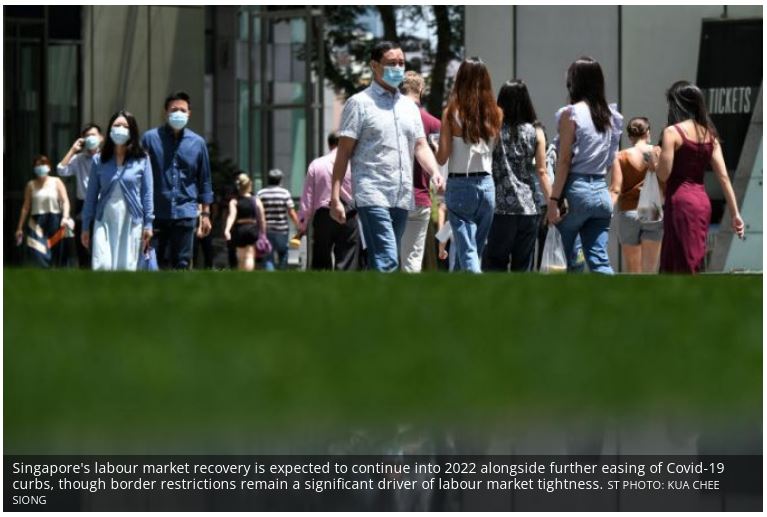Singapore’s labour market recovery to continue into 2022; tightness partly driven by border curbs: MOM
SINGAPORE’S labour market recovery is expected to continue into 2022 alongside further easing of Covid-19 curbs, though border restrictions remain a significant driver of labour market tightness, according to the Manpower Ministry’s (MOM) latest Labour Market Report on Wednesday (Dec 15).
There are now twice as many job vacancies as unemployed persons, but this is partly due to sectors that have lost Work Permit holders, said MOM.
In addition, given the uneven sectoral recovery, MOM “is vigilant to the risk of that some displaced workers may face greater challenges”, said permanent secretary Aubeck Kam.
The report, which updates and expands upon advance estimates released in late-October, confirms a picture of continued recovery in the third quarter of 2021 despite Covid-related restrictions, said Kam.
Total employment fell by 2,400 in Q3, revised down from the advance estimate of 3,400 and significantly less than the 16,300 fall in Q2.
Resident employment rose strongly by 19,100, up from Q2’s 4,800 rise. This partly offset a 21,500 fall in non-resident employment, comparable to Q2’s 21,100 fall.
Retrenchments fell to 1,900 for the quarter, down from 2,340 in Q2, making for a lower incidence of 1.1 retrenchments per 1,000 employees, down from 1.3 before. The 6-month re-entry rate for retrenched residents improved to 66 per cent from 64 per cent before.
There were also fewer employees on a short work-week or temporary layoff – 4,060, down from 5,580 in Q2 – with a notable decrease coming from air transport and supporting services, as companies began ramping up capacity in anticipation of some air travel resumption.
However, the seasonally-adjusted resident long-term unemployment rate rose to 1.2 per cent in September, up from 0.9 per cent in June and remaining above the pre-Covid average.
This was despite further declines in unemployment rates, which each improved 0.1 percentage point to 2.6 per cent overall, 3.5 per cent for residents, and 3.7 per cent for citizens, respectively.
Coming out of a downturn, the long-term unemployment rate will take time to settle back to the normal level, said Kam. “So I think we should not be overly anxious that it remains elevated for now.”
He noted that a fall in long-term unemployment does not necessarily mean that the labour market recovery is strong, because workers fall out of the unemployment statistics if they give up searching for a job and withdraw from the labour market altogether.
Unemployment rates refer to the share of job seekers in the total labour force, with long-term unemployment defined as those who have been unemployed for 25 weeks or more.
Job vacancies rose for the fifth straight quarter to 98,700 in September, from 92,100 in June. There were 209 job vacancies for every 100 unemployed persons, up from 163 in June.
But the MOM noted that this rise “should be seen in the context of border restrictions on the inflow of foreign labour”.
Sectors which have seen substantial decreases in Work Permit holders – manufacturing, construction, food and beverage services, and administrative and support services – accounted for 38 per cent of all job vacancies.
It is very hard to compare the 2.09 ratio of job vacancies to unemployed persons to past rates, given the unprecedented Covid-19 border curbs, said Kam.
“The number of job vacancies, and the ratio of job vacancies to unemployed persons, are expected to remain high until border restrictions are lifted,” said the MOM.
Nonetheless, 30 per cent of all job vacancies were in growth sectors such as professional services, financial services, information and communications, and health and social services, “where resident employment has also increased in tandem”.
In a Facebook post, Manpower Minister Tan See Leng said the latest statistics “indicate that the labour market recovery continued to make good progress”.
“As Singapore moves into the transition phase and restrictions start easing, I am optimistic that the labour market will continue to improve,” he said.
But he noted that Singapore is “not completely out of the woods just yet” as recovery remains uneven. The MOM and tripartite partners will continue to support employers and employees to adapt for a post-Covid economy, pushing out Jobs Transformation Maps for various sectors, he added.
Source: https://www.businesstimes.com.sg/government-economy/singapores-labour-market-recovery-to-continue-into-2022-tightness-partly-driven


 English
English




